Decades-old airbag technology is finally finding its place on two wheels
This year marks the 50th anniversary of the automotive airbag and, after a faltering start, the same technology is finally starting to find a home on two wheels as well – with Piaggio expected to introduce airbag-equipped scooters in the near future in a move that could spark similar moves from its rivals.
There is one bike out there already with an airbag option. Honda has ploughed a lonely furrow with the tech, offering the Goldwing with an airbag since the 2006 model year, but despite 17 years of production across two distinct model generations the Honda airbag hasn’t spread to other models or been copied by rival brands. That now looks set to change, with Autoliv, one of the world’s largest airbag suppliers, joining forces with Piaggio and presenting evidence that airbags – despite some limitations – can be life-savers on two wheels as well as four.

The stuttering adoption of airbags on bikes shouldn’t come as a surprise: despite their ubiquity in today’s cars, it took decades for the technology to be widely accepted in that role. The idea of automotive airbags to reduce injuries in crashes stems back to the 1950s but the first production system appeared on a small number of US-market GM vehicles in 1973 – the Chevrolet Impala and Oldsmobile Toronado led the way, followed by Buicks and Cadillacs, using a sophisticated system that protected all the front occupants.
Safety might sell in the mollycoddling 2020s but back then the option proved spectacularly unpopular; GM dropped it in 1977 thanks to customer apathy towards the idea. From there, the spread of airbags in cars proved slow and stumbling. Mercedes brought its own system to the market in 1981, creating the idea of a ‘Supplemental Restraint System’ to work in harmony with seatbelts rather than in place of them, but it wasn’t until the 90s that airbags really started to become a selling point, finally being mandated for new vehicles in much of the world around the end of that decade.
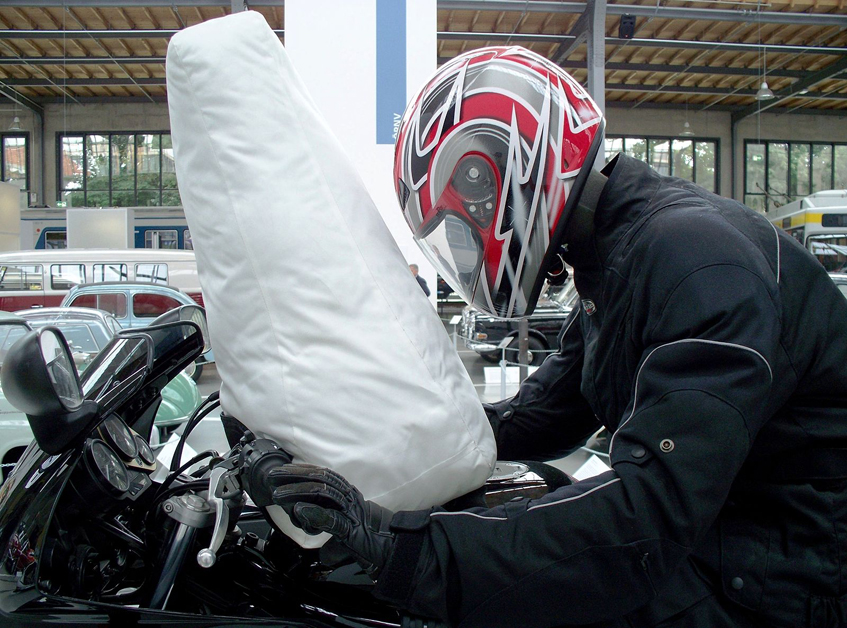
Since then, airbags have exploded – pun absolutely intended – in the four-wheeled space. Side airbags. Curtain airbags. Knee airbags. Seatbelt airbags. The airbags themselves are relatively cheap, compact and lightweight, so there’s no shortage of modern cars with as many as 10 of them scattered around the cabin, and several manufacturers are working on putting them on the outside as well, to protect pedestrians and even motorcyclists.
The same pattern of slow adoption followed by a rapid escalation means that while there’s only one airbag-equipped bike on the market today, in the next few years the same technology could become the norm rather than the exception.

Honda spruiks the airbag in the Goldwing before the technology was introduced in 2006
Autoliv might not be a name that’s familiar to most of us but it’s been a global leader in automotive safety systems for 70 years – pioneering the seatbelt, the seatbelt pretensioner, side airbags and knee airbags among other things and one of the largest manufacturers of airbags in the world. The company’s safety equipment is currently believed to prevent around 35,000 deaths each year, but it wants to increase that number to 100,000 lives saved annually by 2030. Getting airbags onto motorcycles and scooters will be a vital step in achieving that goal.
In 2021, the company signed a deal with Piaggio to develop an airbag system for motorcycles and scooters, and the first fruit of the collaboration was quietly shown at EICMA last November in the form of a Piaggio MP3 with an airbag mounted near the rider’s knees.
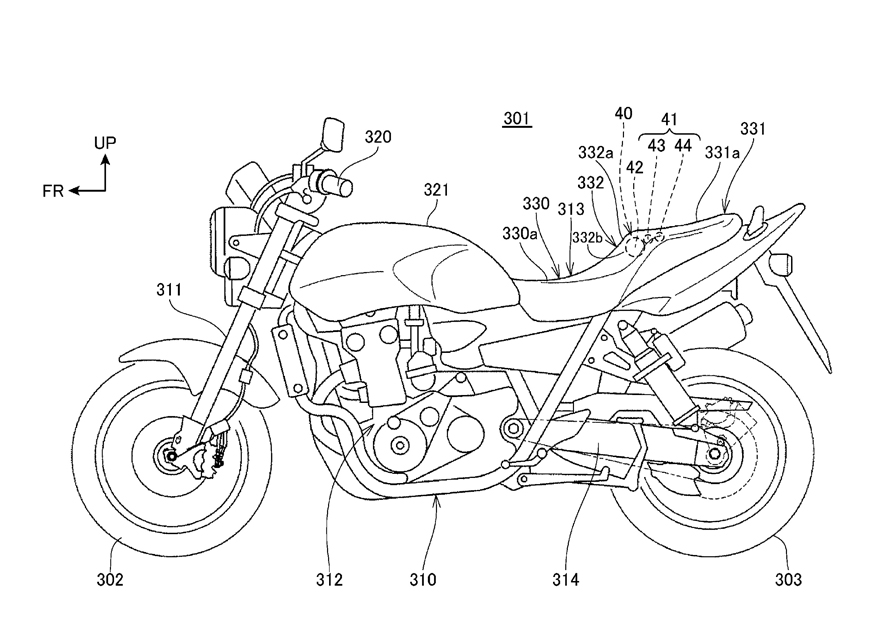
Honda’s patent for a seat-based airbag
Inflating upwards and back towards the rider, the Piaggio/Autoliv airbag creates a soft landing in front of you in the event of a frontal impact, typically the sort of crash that happens when a car turns right across your path from a side road.
Like the airbags in cars, the system uses a gas generator – a chemical reaction sparked by an electrical signal, creating a huge amount of inert gas that fills the bag in the fraction of a second before you’re thrown forwards into it.
The idea is to slow the rate of deceleration in a crash, with a particular focus on particularly vulnerable body parts like the head and neck, to a point at which you mitigate injuries. In its airbag research, Autoliv delved into three large-scale traffic accident studies to gather data, highlighting notable differences between the crashes and injuries in different parts of the world. The GIDAS (German In-Depth Accident Study) represented the sort of accidents found in affluent countries, where riders are more likely to wear good safety kit and helmets. It’s compared with results from CIDAS (China In-Depth Accident Study) and RASSI (Road Accident Sampling System: India) research, showing the sort of injuries suffered in markets dominated by lower-performance bikes and scooters, city traffic and relatively low levels of helmet use.
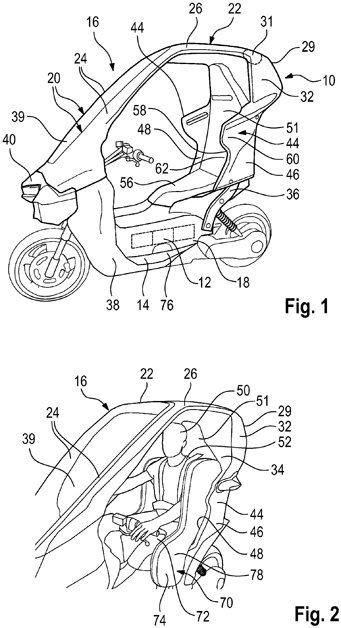
BMW Motorrad has ventured into the side airbag space
The differences are stark. Looking at ‘serious to fatal’ motorcycle accidents in collisions with other vehicles, the German study found that riders’ legs are most vulnerable, accounting for 31 percent of injuries, while head injuries account for only 16 percent. In China and India, head injuries are the most significant factor, at 31 percent and 34 percent respectively, with leg injuries in second place at 24 percent in both countries.
While Autoliv is involved in both ‘on-rider’ airbags – those mounted in clothing – and ‘on-vehicle’ solutions, the latter is particularly valuable because it doesn’t rely on the rider taking responsibility for his or her own safety and dressing appropriately. You can’t guarantee riders will wear helmets or take any other precautions, but you can’t have a bike crash without a bike – so if the airbag is part of the motorcycle itself, it will be there when it’s needed.
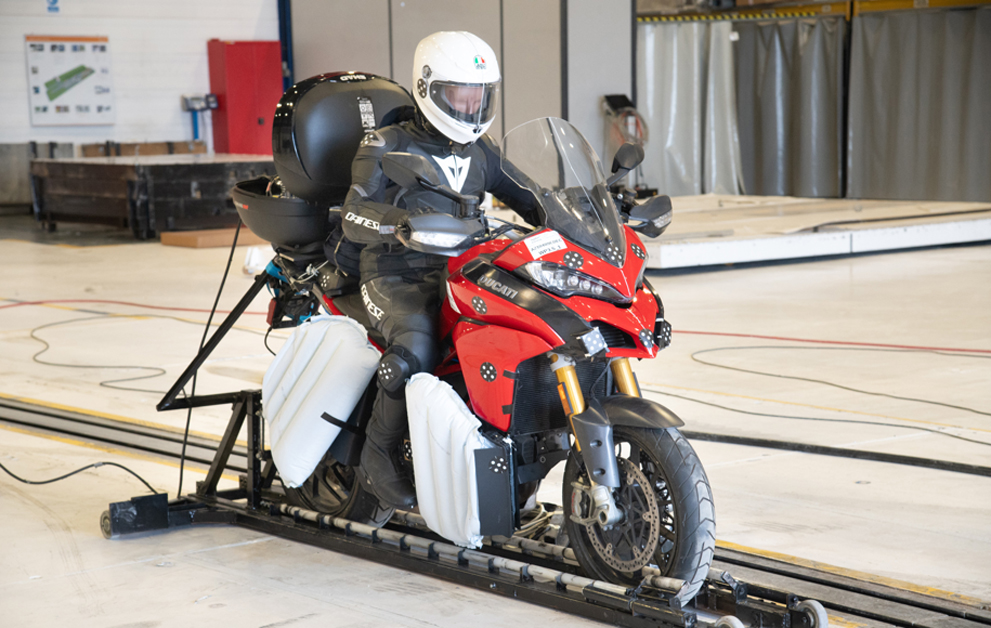
Using both real and simulated crash tests, focusing on 50km/h crashes into the side of a car, Autoliv established that airbags can have a huge effect on outcomes. Specifically, the tests showed that with no airbag the crash test dummy’s head suffered 130g of deceleration for more than three milliseconds, nearly twice the 72g limit that’s targeted in crash tests. With an airbag, the same crash test resulted in 51g head deceleration, a figure far less likely to result in injury.
The tests also looked at ‘Head Injury Criterion’ (HIC) – a standard calculation based on forces experienced by the test dummy’s head over a period of time during an accident – to work out the risk of a head injury. The target figure to avoid injury was 500, but with no airbag the result was more than 13 times that, at 6794. With the airbag, the HIC figure dropped to just 118.

Autoliv’s scooter airbag, which will be particularly beneficial in the high-saturation and bustling Indian and Asian markets
It’s a similar story when it comes to neck injuries. The injury threshold for ‘shear force’ was set at 1.9 kilonewtons (kN). Without an airbag, the result was 2.9kN of shear force, but with it the figure was slashed to just 0.9kN. Another measurement for neck extension, measured in Nm and with an injury threshold of 42Nm, was reduced from 48Nm without an airbag to 11Nm with the airbag.
We spoke to Atsushi Ishii, Autoliv’s Head of Technology – Mobility Safety Solutions, to find out more about the company’s airbag system and its plans for the future. He said: “Motorcycles are a strange thing compared to cars. You lean, you pitch, you can do wheelies, so compared to a car there are more needs in order to make it safe. Perhaps we can’t make it as safe as a car, but we can make it much, much safer,” Ishii explains. “We need to start somewhere, so we are starting with frontal airbags, the position that we can save the most lives, and it will creep down to other cases, like side impacts, low sides or high sides. It was similar with cars. In the beginning they had the airbag in the steering wheel. Today they have side curtains and everything else. The motorcycle business needs to make the same journey.”
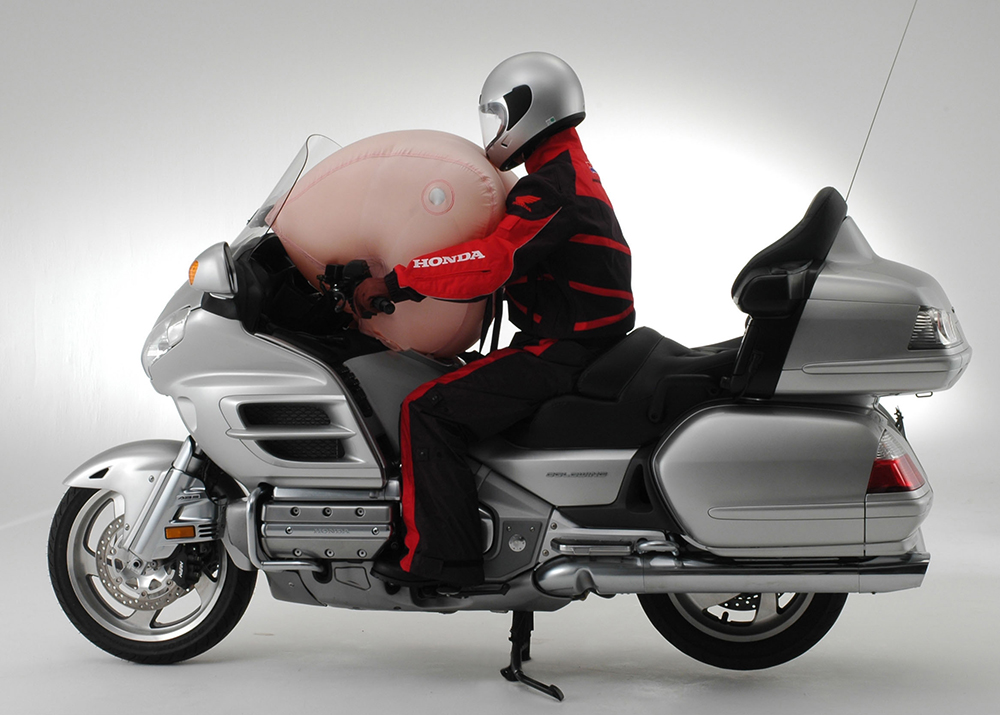
Takata was the original airbag supplier for the Goldwing, but various faults necessitated a massive global recall
Autoliv’s airbag system itself isn’t that different to the one you’ll find in a car. Using similar technology means costs can be kept down and production ramped up rapidly.
“For the airbag system, basically we need a crash sensor, we need a detection ECU, we need wiring harnesses and we need an airbag module, so it’s not that different to a car,” Ishii said. “However, one of the trickiest things on a motorcycle is that on a car you have crash deformation cells, you have the bonnet, so you don’t need to be super quick. But on a motorcycle you don’t have the crash deformation cells so you need to have really good algorithms in order to trigger [the airbag] fast. The advancement of electronics has helped make this feasible.”
The requirement for rapid deployment of the airbag poses specific problems for certain bikes. “We know we can put this on a cheap scooter, we can put it on a 125, I think the trickiest one is sportsbikes, because you’re basically sitting on the tank, or leaning towards the tank,” Ishii explains. “We will solve it, but it’s not our first choice because if you look at worldwide sales, supersports motorcycles don’t sell too much at the moment. Our mission is to save as many lives as possible, so we know which motorcycles we should start with.”
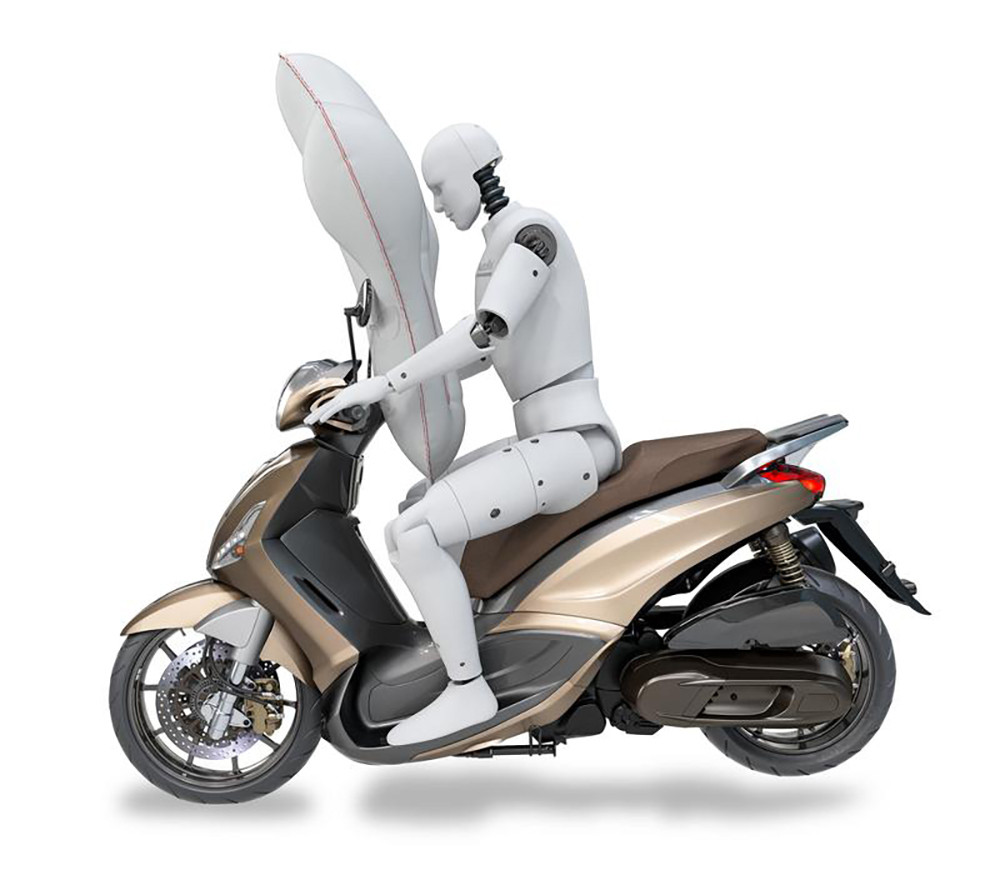
Airbags on scooters don’t present as many problems as sportsbikes, where riders are leaning forward
Other bikes with more upright riding positions are all well-suited to the Autoliv technology, including adventure bikes that are still dominating many sales charts, but the biggest safety gains will come from fitting airbags to scooters and small bikes used in Asian and Indian markets. “I’m pretty confident to say we can be cheap enough to put it on almost every motorcycle that’s sold in southeast Asia if there’s demand for it.”
In the meantime, you’re probably wondering how soon the Autoliv on-bike airbag will be seen on a production model. The answer is that it’s coming for the 2025 model year. How it spreads from there will depend on whether buyers embrace the technology, but Ishii reckons that it will be around five years before there’s a mass adoption of motorcycle airbags.
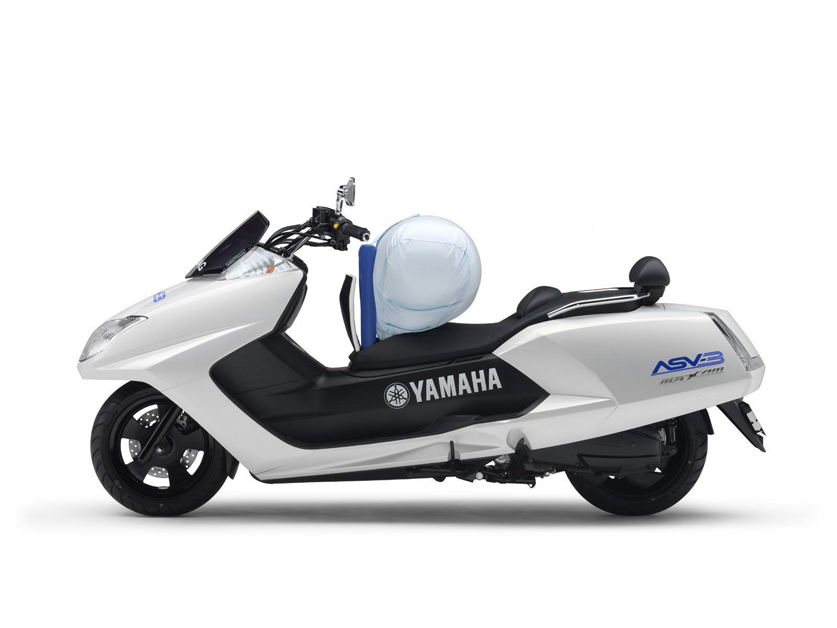
Yamaha has also played with the idea of airbags, using them on a series of ‘ASV’ Advanced Safety Vehicle prototypes
Words Ben Purvis